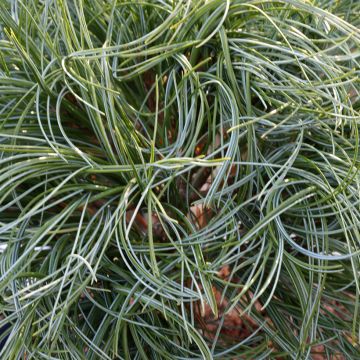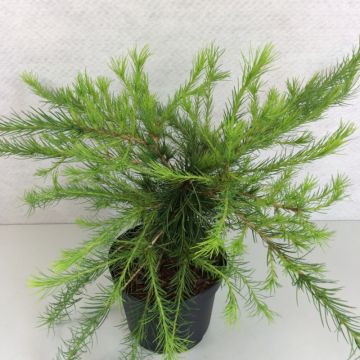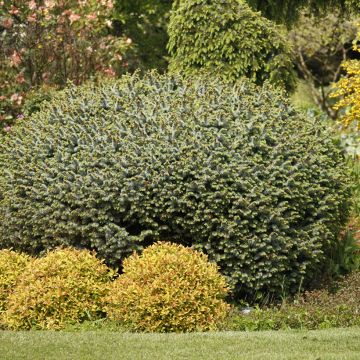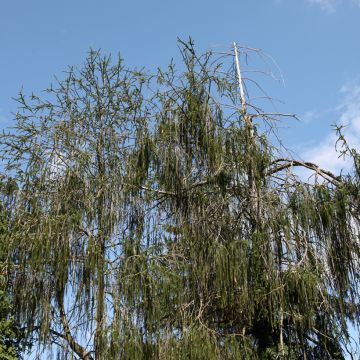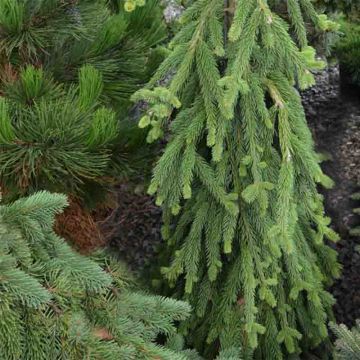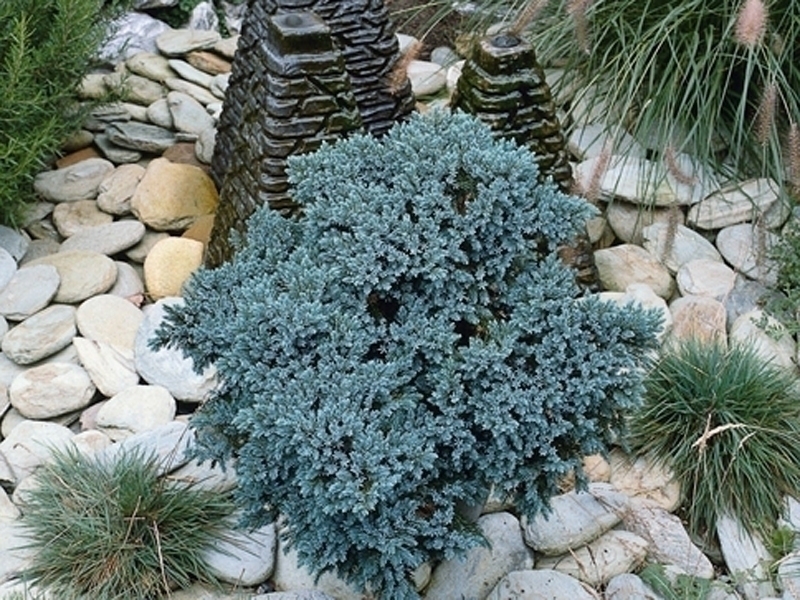

Wollemia nobilis


Wollemia nobilis


Wollemia nobilis


Wollemia nobilis


Wollemia nobilis
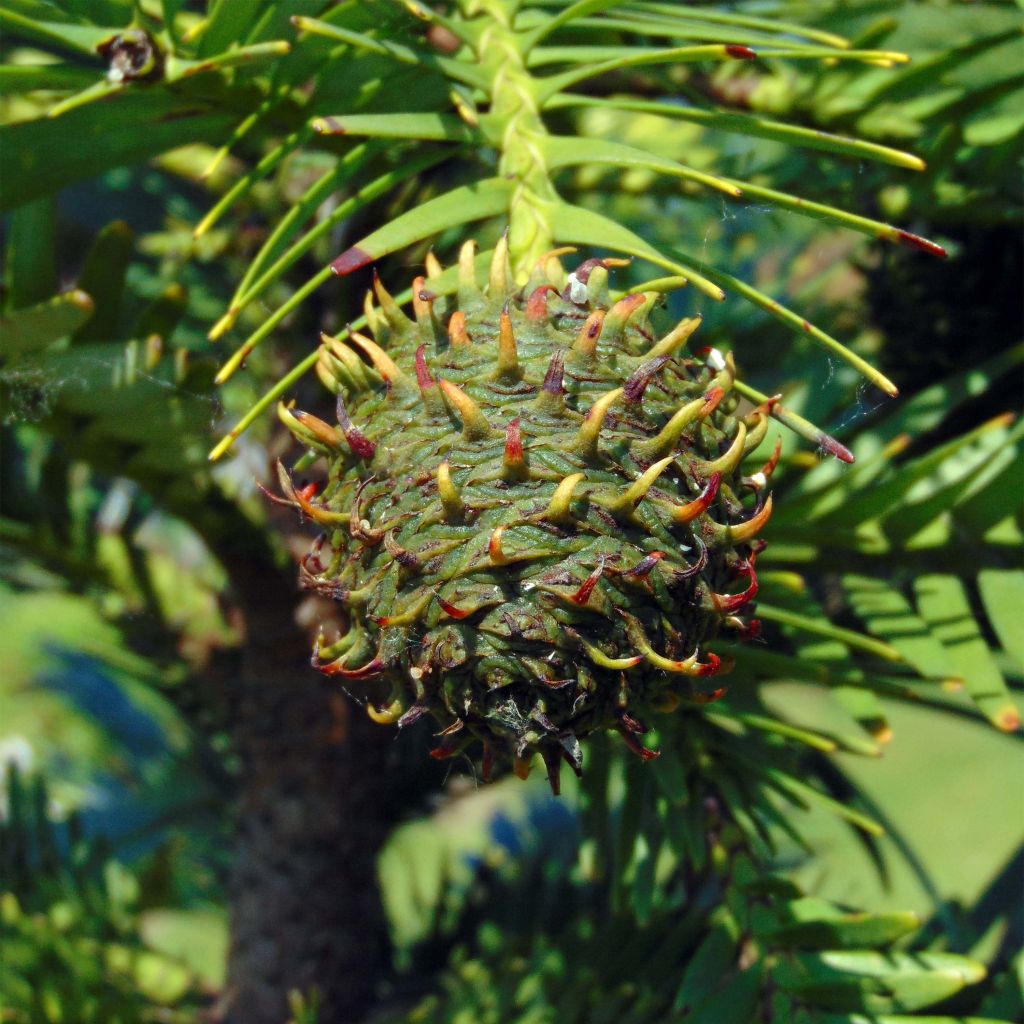

Wollemia nobilis
Wollemia nobilis
Wollemia nobilis
Wollemi Pine
Passionate about my garden, I received it as a gift last CHRISTMAS!! I planted it immediately in a clear spot in the garden, it started quite late (end of April) and today the spring shoot is about 30 centimetres (12 inches) long... it is in the middle of a short grass meadow with automatic watering. I look at it every day, I took a photo of it when I planted it, and plan to do so once a year.... It is a magnificent tree.
ALIE, 21/07/2021
Special offer!
Receive a €20 voucher for any order over €90 (excluding delivery costs, credit notes, and plastic-free options)!
1- Add your favorite plants to your cart.
2- Once you have reached €90, confirm your order (you can even choose the delivery date!).
3- As soon as your order is shipped, you will receive an email containing your voucher code, valid for 3 months (90 days).
Your voucher is unique and can only be used once, for any order with a minimum value of €20, excluding delivery costs.
Can be combined with other current offers, non-divisible and non-refundable.
Why not try an alternative variety in stock?
View all →This plant carries a 24 months recovery warranty
More information
We guarantee the quality of our plants for a full growing cycle, and will replace at our expense any plant that fails to recover under normal climatic and planting conditions.
Would this plant suit my garden?
Set up your Plantfit profile →
Description
The Wollemi Pine, in Latin Wollemia nobilis, is a very rare example of plant resurrection. This large conifer, believed to be extinct forever, was rediscovered alive and well in 1994, in the depths of a small valley located not far from Sydney in Australia. It is such a rare plant - there are only a few dozen adult specimens left - that the exact location of its discovery remains, to this day, a secret. The achievements of plant biotechnology have allowed it to be quickly multiplied, allowing gardeners around the world to try their hand at its cultivation, in order to perpetuate this strange and magnificent organism that is truly endangered. Picture a tall, slender fir tree with a trunk covered in swollen, chocolate-coloured bark, with low branches adorned with fronds of tender green fern, and topped with a tightly cone-shaped crown. Tomorrow, it may flourish in your garden. This dream, within reach of a shovel, could well come true under a mild oceanic climate, in deep, humus-rich or sandy soil with a tendency towards acidity.
Wollemia nobilis belongs to the Araucariaceae family, one of the oldest from a botanical point of view. It now includes the genera Wollemia, Araucaria and Agathis, the last representatives of a group of plants that thrived in the Jurassic period. The nobilis species is the only current representative of the genus. This conifer is native to Wollemi National Park, located in the Blue Mountains region of southeastern Australia, subjected to temperatures ranging from -5 °C (23 °F) in winter to 45 °C (113 °F) in summer. Successful cultivation trials in different regions of the world have confirmed the resistance of this conifer to temperatures as low as -12 °C (10.4 °F).
In its natural environment, confined to a small, narrow valley with greasy, moist soil, the few adult Wollemia nobilis trees reach a height of 35 m (115 ft) and have a generally narrow, pyramidal habit. While it initially grows with a single trunk, it develops several more over time. This ability to regenerate from its stump is an adaptation to forest fires that regularly ravage this Australian region. It can also be found in certain eucalyptus trees or in the Sequoia. The diameter of the main trunk can exceed 1 m (3 ft). Its strange, dark brown bark has many spongy nodules. It peels off in scales that resemble chocolate-coated puffed cereals. The evergreen foliage is dark green, but the young shoots are lighter green. The branches that grow at the base of the trunk bear long, narrow, and flexible leaves arranged in two regular rows. Towards the top of the tree, the leaves and branches take on a different appearance: shorter, stiffer, and wider, arranged in four rows, the needles cover upright branches that are gathered in a conical tuft. This conifer renews its foliage from top to bottom, shedding entire branches that are replaced by dormant buds lower on the trunk. The young shoots are protected throughout the winter by a thick, pink-coloured waxy layer, aptly named "polar cap" by botanists. The female cones, located towards the top, contain globular-shaped seeds and measure 10 cm (4 in) in length, with pointed scales. The male cones, which bear pollen, measure 15 cm (6 in) in length. They appear at a lower level on the tree.
The Wollemi Pine is a true vegetal dinosaur. This botanical curiosity will find its place in a park, on a large plot of land, isolated, at the back of a flower bed, or in a very large container on the terrace. Its good tolerance to pruning allows it to maintain more manageable proportions in a pot or on a smaller-sized plot of land. Like its cousin, the Araucaria, it stands out as eccentric and intrigues enthusiasts of strange plants. Adopt this endangered large conifer: place it at the borders of your estate, where its strange structure will stand out, like a solitary emergence, from a grove of evergreen or deciduous trees. As it is a bit sensitive to cold and dislikes heat and drought, it will thrive on oceanic coasts in temperate climates.
Wollemia nobilis in pictures
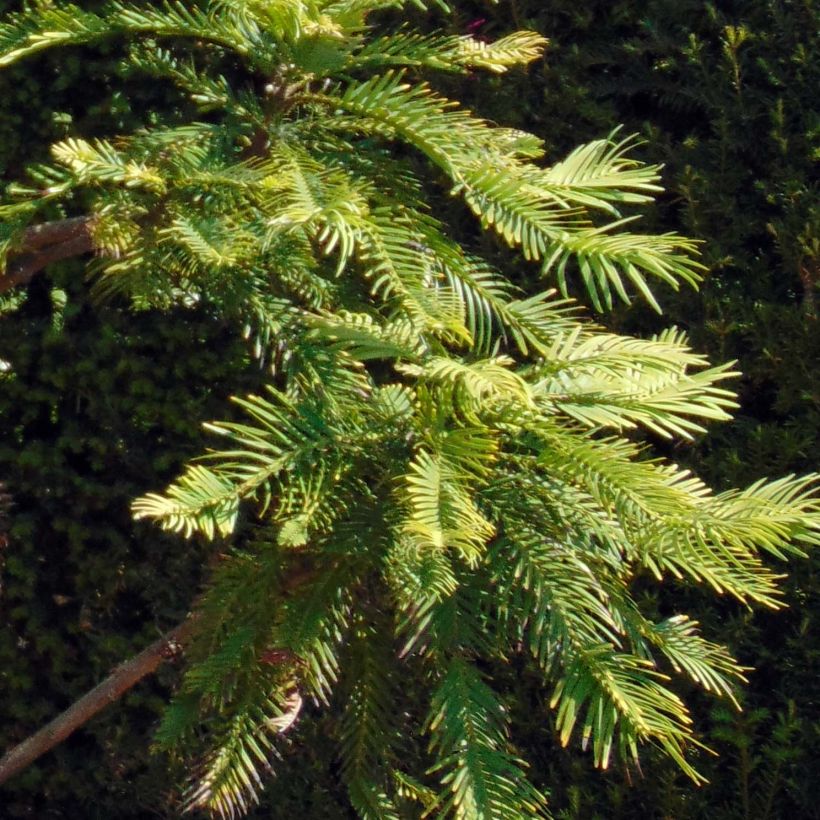



Plant habit
Foliage
Botanical data
Wollemia
nobilis
Araucariaceae
Wollemi Pine
Australia
Other Conifers A to Z
View all →Planting and care
Knowledge regarding the cultivation requirements and limits of the Wollemi Pine is still somewhat limited. Due to its origins, it thrives in a deep, sandy and humus-rich soil that is acidic and remains moist to wet. It requires a position sheltered from strong winds, plenty of sunlight, and a mild climate as its hardiness is compromised below -12 °C (10.4°F), with young plants suffering from temperatures as low as -5 °C (23 °F). It is sensitive to heat and summer drought and shows a clear preference for mild and humid climates, and even misty environments in summer. It requires very little maintenance, except for regular watering during its establishment and the first two or three summers in case of drought. We also recommend spraying the foliage of young plants during summer for the first two or three years after planting. Apply a handful of well-rotted compost or slow-release fertiliser in autumn and early spring to support growth.
When all these conditions are met, this tree grows fairly quickly and without any issues. It is not prone to specific diseases in our climates.
Pot cultivation:
Prepare a mixture of heath soil, coarse sand, leaf mould, and compost. Water regularly throughout the year without excess. Wait until the surface of the substrate is dry to the touch. In spring, apply a slow-release fertiliser that is low in phosphorus (P). Supplement with liquid fertiliser once or twice a month from May to September. Store the pot indoors as soon as the nighttime temperatures drop below 2 °C (35.6 °F).
Every 2 to 3 springs, repot your Wollemi Pine in new substrate and a slightly larger container.
Pruning: It is not necessary, but this conifer tolerates it well, which makes pot cultivation possible. Shorten up to two-thirds of its branches. Only intervene if necessary, in late winter, to manage its size and improve its shape. Both the top part (apex) of the tree and the ends of the lateral branches can be shortened.
Propagation: by spring sowing, which is difficult.
Planting period
Intended location
Care
Planting & care advice
-
, onOrder confirmed
Reply from on Promesse de fleurs
Similar products
Haven't found what you were looking for?
Hardiness is the lowest winter temperature a plant can endure without suffering serious damage or even dying. However, hardiness is affected by location (a sheltered area, such as a patio), protection (winter cover) and soil type (hardiness is improved by well-drained soil).

Photo Sharing Terms & Conditions
In order to encourage gardeners to interact and share their experiences, Promesse de fleurs offers various media enabling content to be uploaded onto its Site - in particular via the ‘Photo sharing’ module.
The User agrees to refrain from:
- Posting any content that is illegal, prejudicial, insulting, racist, inciteful to hatred, revisionist, contrary to public decency, that infringes on privacy or on the privacy rights of third parties, in particular the publicity rights of persons and goods, intellectual property rights, or the right to privacy.
- Submitting content on behalf of a third party;
- Impersonate the identity of a third party and/or publish any personal information about a third party;
In general, the User undertakes to refrain from any unethical behaviour.
All Content (in particular text, comments, files, images, photos, videos, creative works, etc.), which may be subject to property or intellectual property rights, image or other private rights, shall remain the property of the User, subject to the limited rights granted by the terms of the licence granted by Promesse de fleurs as stated below. Users are at liberty to publish or not to publish such Content on the Site, notably via the ‘Photo Sharing’ facility, and accept that this Content shall be made public and freely accessible, notably on the Internet.
Users further acknowledge, undertake to have ,and guarantee that they hold all necessary rights and permissions to publish such material on the Site, in particular with regard to the legislation in force pertaining to any privacy, property, intellectual property, image, or contractual rights, or rights of any other nature. By publishing such Content on the Site, Users acknowledge accepting full liability as publishers of the Content within the meaning of the law, and grant Promesse de fleurs, free of charge, an inclusive, worldwide licence for the said Content for the entire duration of its publication, including all reproduction, representation, up/downloading, displaying, performing, transmission, and storage rights.
Users also grant permission for their name to be linked to the Content and accept that this link may not always be made available.
By engaging in posting material, Users consent to their Content becoming automatically accessible on the Internet, in particular on other sites and/or blogs and/or web pages of the Promesse de fleurs site, including in particular social pages and the Promesse de fleurs catalogue.
Users may secure the removal of entrusted content free of charge by issuing a simple request via our contact form.
The flowering period indicated on our website applies to countries and regions located in USDA zone 8 (France, the United Kingdom, Ireland, the Netherlands, etc.)
It will vary according to where you live:
- In zones 9 to 10 (Italy, Spain, Greece, etc.), flowering will occur about 2 to 4 weeks earlier.
- In zones 6 to 7 (Germany, Poland, Slovenia, and lower mountainous regions), flowering will be delayed by 2 to 3 weeks.
- In zone 5 (Central Europe, Scandinavia), blooming will be delayed by 3 to 5 weeks.
In temperate climates, pruning of spring-flowering shrubs (forsythia, spireas, etc.) should be done just after flowering.
Pruning of summer-flowering shrubs (Indian Lilac, Perovskia, etc.) can be done in winter or spring.
In cold regions as well as with frost-sensitive plants, avoid pruning too early when severe frosts may still occur.
The planting period indicated on our website applies to countries and regions located in USDA zone 8 (France, United Kingdom, Ireland, Netherlands).
It will vary according to where you live:
- In Mediterranean zones (Marseille, Madrid, Milan, etc.), autumn and winter are the best planting periods.
- In continental zones (Strasbourg, Munich, Vienna, etc.), delay planting by 2 to 3 weeks in spring and bring it forward by 2 to 4 weeks in autumn.
- In mountainous regions (the Alps, Pyrenees, Carpathians, etc.), it is best to plant in late spring (May-June) or late summer (August-September).
The harvesting period indicated on our website applies to countries and regions in USDA zone 8 (France, England, Ireland, the Netherlands).
In colder areas (Scandinavia, Poland, Austria...) fruit and vegetable harvests are likely to be delayed by 3-4 weeks.
In warmer areas (Italy, Spain, Greece, etc.), harvesting will probably take place earlier, depending on weather conditions.
The sowing periods indicated on our website apply to countries and regions within USDA Zone 8 (France, UK, Ireland, Netherlands).
In colder areas (Scandinavia, Poland, Austria...), delay any outdoor sowing by 3-4 weeks, or sow under glass.
In warmer climes (Italy, Spain, Greece, etc.), bring outdoor sowing forward by a few weeks.

































